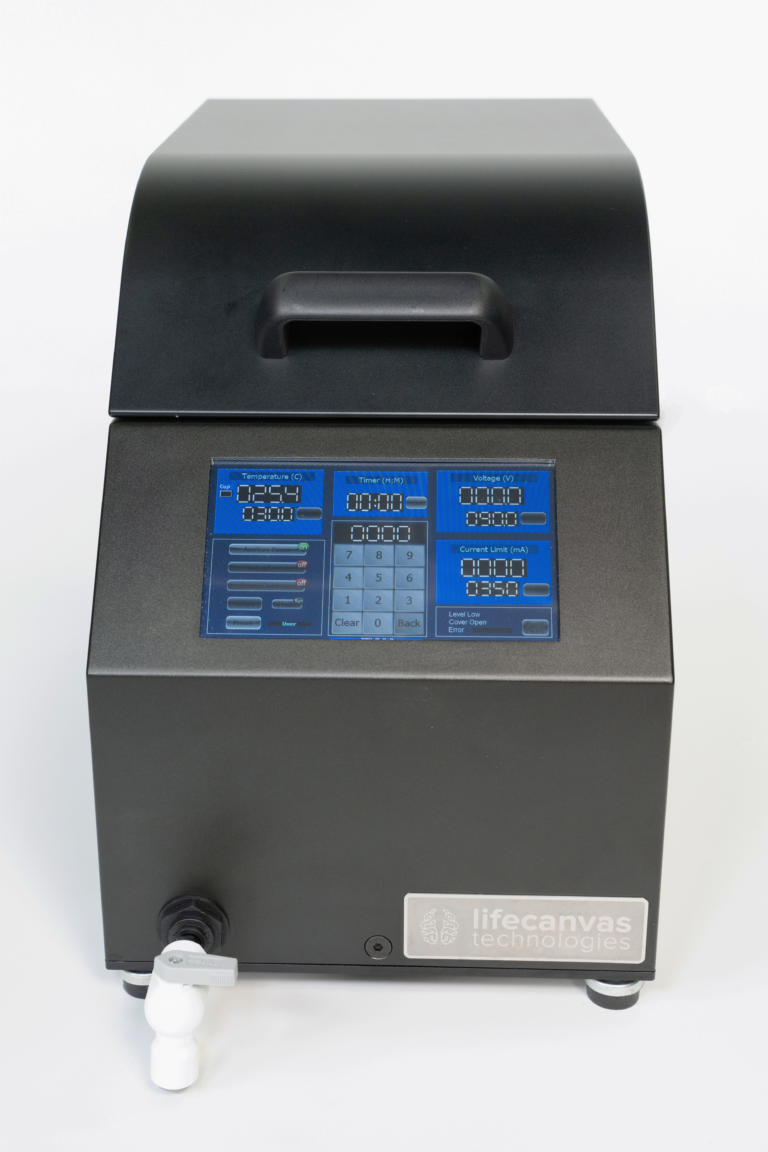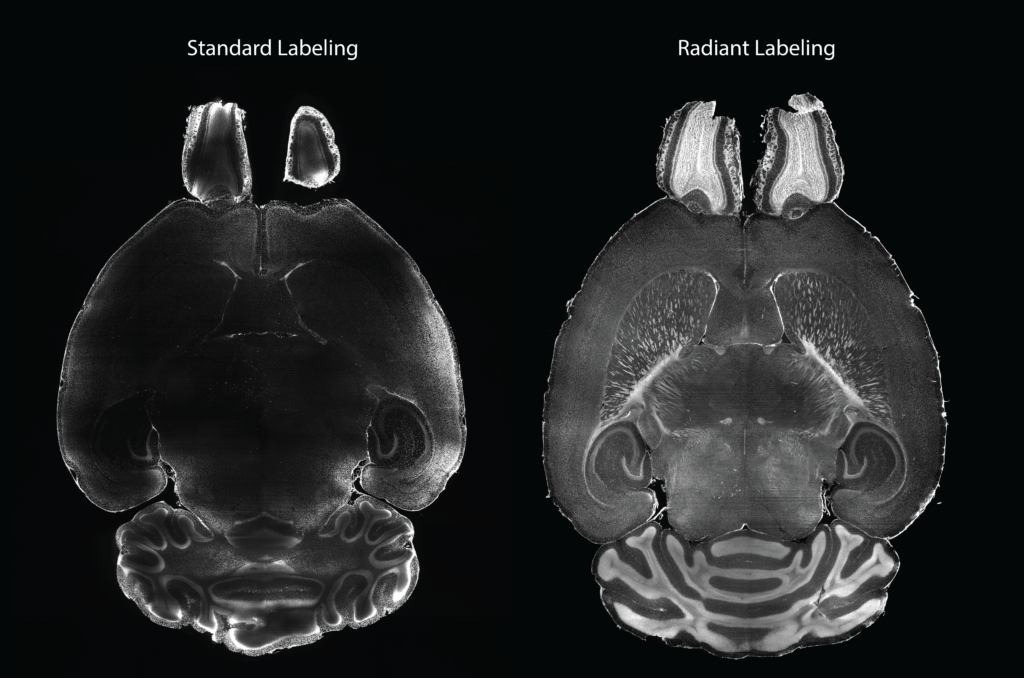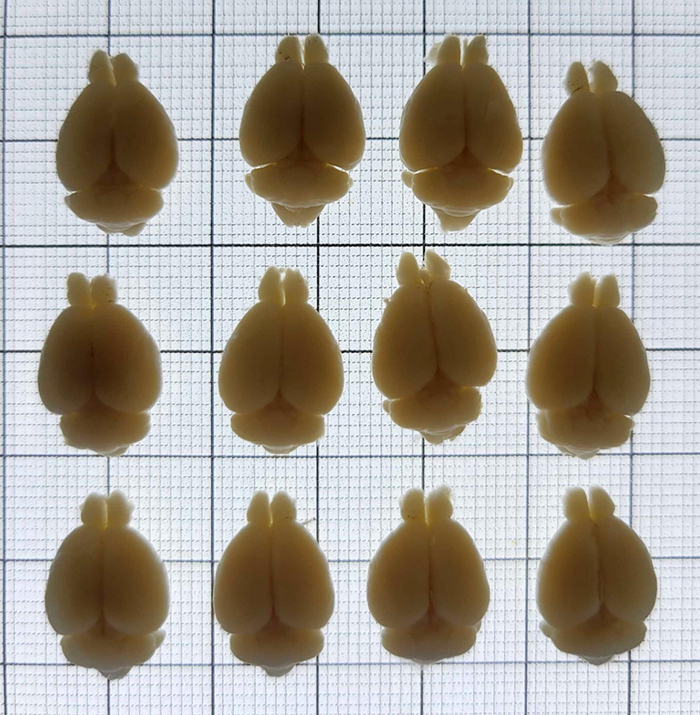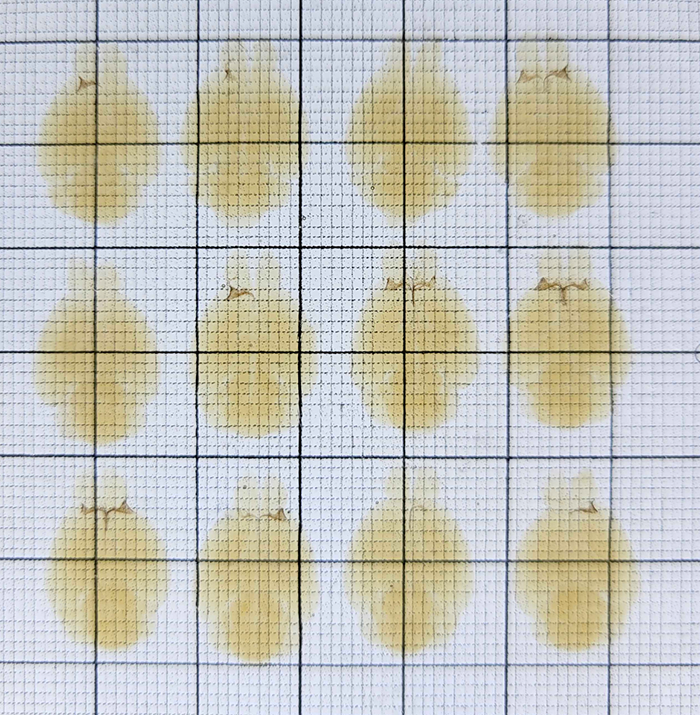Our easy-to-use system combines active tissue clearing and immunolabeling into one high-throughput device, allowing you to switch between clearing and labeling modes simply by changing buffers. SmartBatch+ is compatible with different tissue types and large intact samples.
An advance on our founder’s CLARITY tissue clearing method, Clear+ provides maximum optical transparency with no tissue expansion or contraction. In immunolabeling mode, eFLASH and patented SE technologies uniformly label whole organs. Unlike other methods like iDISCO and CUBIC, SmartBatch+ actively preserves fluorescent protein signal.

All new SmartBatch+ units will come with the Radiant hardware installed, which includes a new column, lid piece, customer L-shaped tube, and connector.
Current SmartBatch+ owners, will require a Radiant hardware upgrade wich is available for purchase.
The SmartBatch+ Radiant buffer system has been designed specifically to enhance the precision and efficiency of your labeling processes by incorporating an enhanced affinity sweep. With our newly developed Radiant Buffer and Catalyst, labeling highly abundant targets has never been easier. This feature effectively suppresses surface labeling for targets with high abundance, allowing antibodies to penetrate tissues more thoroughly and uniformly before binding. These advanced reagents are engineered to complement the upgraded SmartBatch+ with Radiant Buffer compatible hardware.
Recommended for use in challenging scenarios such as:
Utilizing the SmartBacth+ Radiant Buffer System, your SmartBatch+ will be versatile enough to handle targets of any abundance across all tissue types. The SmartBatch+ remains fully compatible with our existing clearing and standard labeling buffer systems. Easily swap to the Radiant Buffer System, ensuring seamless transitions between our protocols.



SmartBatch+ actively clears and labels up to 12 whole mouse brains or comparably sized samples in as little as one day, and 2 whole rat brains in just 3-4 days! This provides unparalleled consistency for multiple treatment groups. Its small footprint also allows ample space for multiple devices.
SmartBatch+ combined with SHIELD tissue preservation protects fluorescent protein signal, antigenicity, and molecular and physical architecture through all tissue processing steps. Clear+ is currently the only tissue clearing technique that preserves sample morphology. This ensures your samples will produce information-rich images.
Use just 4-20 μg of antibody per target to label a sample the size of a whole mouse brain — up to an order of magnitude less than passive staining. Save hundreds of dollars per sample per antibody, in primary antibody alone! SmartBatch+’s turnkey design is also labor-efficient, requiring <12 mins hands-on time per sample to clear and label.

Our full pipeline kits include all reagents and buffers to protect, delipidate, label and index match your tissue samples with SmartBatch+.
Reagent Kit for Full Pipeline for 25 Mouse Brain Sized Samples
Reagent Kit for Full Pipeline for 50 Mouse Brain Sized Samples
Reagent Kit for Full Pipeline for 100 Mouse Brain Sized Samples
Ahmadreza Attarpour, Jonas Osmann, Anthony Rinaldi, Tianbo Qi, Neeraj Lal, Shruti Patel, Matthew Rozak, Fengqing Yu, Newton Cho, Jordan Squair, JoAnne McLaurin, Misha Raffiee, Karl Deisseroth, Gregoire Courtine, Li Ye, Bojana Stefanovic & Maged Goubran
Christina A. von Roemeling, Jeet A. Patel, Savannah L. Carpenter, Oleg Yegorov, Changlin Yang, Alisha Bhatia, Bently P. Doonan, Rylynn Russell, Vrunda S. Trivedi, Kelena Klippel, Daniel H. Ryu, Adam Grippin, Hunter S. Futch, Yong Ran, Lan B. Hoang-Minh, Frances L. Weidert, Todd E. Golde & Duane A. Mitchell
Stephanie E. Brown, Ziyi (Zephyr) Wang, Emily L. Newman, Elif Engin, Sabina Berretta, Darrick T. Balu, Oluwarotimi O. Folorunso.
For technical support reach out to our dedicated customer support team at support@lifecanvastech.com.